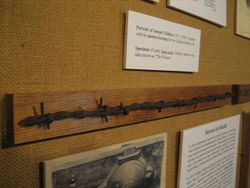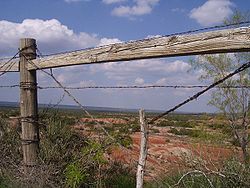سلك شائك
الأسلاك الشائكة نوع من الأسلاك تُصنع من سلكين أو أكثر، يُجدل بعضها مع بعض وعليها فواصل من شوك. وتستعمل في عمل السياج، وخاصة حول حظائر الماشية والأغنام.
. . . . . . . . . . . . . . . . . . . . . . . . . . . . . . . . . . . . . . . . . . . . . . . . . . . . . . . . . . . . . . . . . . . . . . . . . . . . . . . . . . . . . . . . . . . . . . . . . . . . . . . . . . . . . . . . . . . . . . . . . . . . . . . . . . . . . . . . . . . . . . . . . . . . . . . . . . . . . . . . . . . . . . . .
التاريخ

عندما استقر المستوطنون الأمريكيون في الهضاب والسهول التي كان الحطب فيها نادرًا، زرعوا الشجيرات لتسييج الحظائر، واستعملوا شجيرات أمثال المكلُورة البرتقالية ذات الأشواك التي تنمو بشكل كثيف بحيث يمكن أن تحتجز الحيوانات. وجاءت فكرة اختراع الأسلاك الشائكة من هذه الشجيرات ذات الأشواك. أدخل جوزيف غليدن وهو من دي كالب بإلينوي في الولايات المتحدة الأمريكية الأسلاك الشائكة تجاريًا لأول مرة في عام 1874م. قاوم أصحاب الماشية استعمال الأسلاك الشائكة لأنه مكّن صغار الفلاحين من تسييج المساكن حول الأراضي الحكومية التي كانوا يستعملونها مراعيَ مجانية؛ فوضعت الأسلاك الشائكة بذلك حدًّا للمرعى المفتوح، وتمكن صغار الفلاحين من الاستقرار في أراضٍ محددة.

سياج الأراضى الزراعية
البوابات

انظر أيضا
- توربيد بانگالور، كان يستخدم في الحرب العالمية الأولى والثانية لخرق الأسلاك الشائكة
- إسحق ل. إلوود
- Jacob Haish
- جوسف فيروِل گلِدن
- Wire obstacle
المصادر
- Henry D. and Frances T. McCallum. The Wire that Fenced the West. Norman: University of Oklahoma Press, 1965. LoC: 65-11234.
- Olivier Razac. Barbed Wire: A Political History, W. W. Norton & Company, 2003, ISBN 1-56584-812-8
- Reviel Netz. Barbed wire. An ecology of modernity, Wesleyan University Press, 2004, ISBN 978-0-8195-6719-2
- Biography of John W. Gates, barbed wire promoter who monopolized the industry with the American Steel and Wire Company, accessed March 29, 2006
وصلات خارجية
| سلك شائك
]].معلومات
- Website of the Devils Rope Museum in McLean, Texas; a large museum in a converted brassiere factory dedicated to the history of barbed wire, fencing tools, and ranching heritage. Features exhibits from private wire collectors from across the U.S., a reference library with extensive patent information for researchers and educators, a dust bowl exhibit, salesman samples, warfare wire, and a collection of road lore with artifacts dedicated to the Texas portion of Historic Route 66.
- History of the invention of barbed wire
- Barbed Wire Photo Gallery: DeKalb photos included, barbed wire examples pgs. 3 thru 24.
- Development and Rise of Barbed Wire at University of Virginia accessed March 29, 2006
- Barbed Wire Fencing - Its Rise and Influence also at UVA, from Agricultural History, Volume 13, October 1939, accessed September 20, 2006
- Glidden's patent for barbed wire accessed March 29, 2006
- Antique Barbed Wire Society accessed September 21, 2006
- Barbed Wire in Texas
- Barbed wire changes life on the American Great Plains
- Interesting snippets and references to barbed wire
- A political history of barbed wire
- The historical plaque outside Menger Hotel in San Antonio erected in 2000, accessed 14 November 2005.
- The History of Barbed Wire About.com
- The Wildlife Friendly Fencing project
- Papers, 1878-1938, of Texas rancher and co-inventor Isaac L. Ellwood in Southwest Collection/Special Collections Library at Texas Tech University
براءات اختراع - (حوالي 570 براءة مسجلة):
- Patent history accessed September 21, 2006
- U.S. Patent 66٬182 - Lucien Smith, Kent, Ohio, Wire fence - "rotary spools with projecting spurs" (June 1867)
- U.S. Patent 67٬117 - William Hunt, Scott, New York, Improvement in Fences - "sharpened spur wheels" (July 1867)
- U.S. Patent 74٬379 - Michael Kelly, مدينة نيويورك (!), Improvement in Fences - "thorny fence" (1868)
- U.S. Patent 116٬755 - Joshua Rappleye, Seneca County, New York, Improvement in Constructing Wire fence - tensioner for fence with palings (pickets) (1871)
- U.S. Patent 138٬763 - Henry Rose, DeKalb County, Illinois, Improvement in Wire-fences – "strips provided with metal points" (1873)
- U.S. Patent 147٬756 – Isaac Ellwood, DeKalb, Illinois Improvement in Barbed Fences – "single piece of metal with four points, attached to a flat rail" (February, 1874)
- U.S. Patent 157٬124 - Joseph Glidden, DeKalb, Illinois, Improvement in Wire-fences - twisted fence wires with short spur coiled around one of the strands (November, 1874) This became the most popular patent.
- U.S. Patent 167٬240 - Jacob Haish, DeKalb, Illinois, Improvement in Wire-fence Barbs - "single piece of wire bent into the form of the letter S" so that both strands are clasped (1875)
- U.S. Patent 185٬346 – John Nelson, Creston, Illinois, Improvement in Wire-fence Barbs – barb installable on existing fence wire, (1876)





